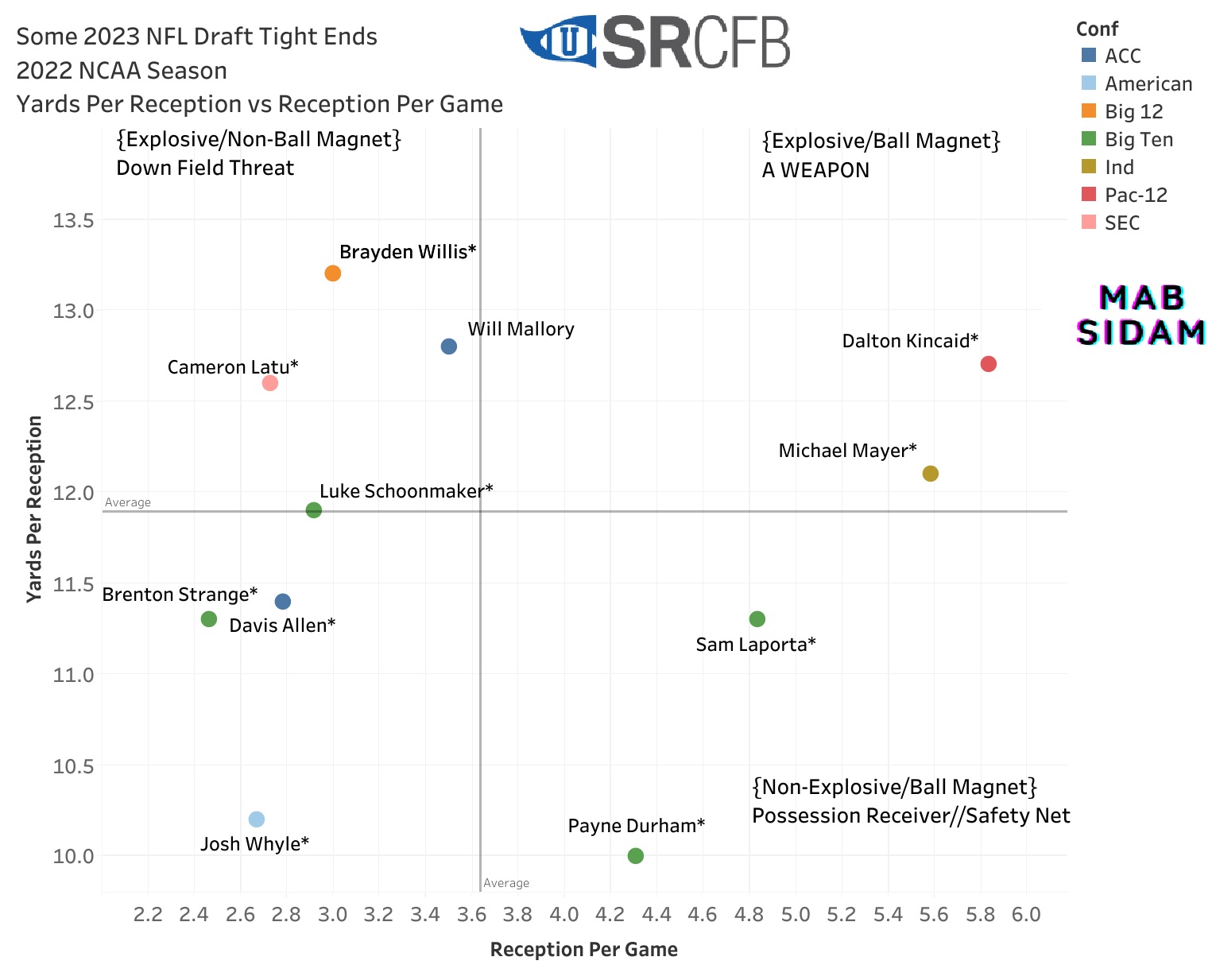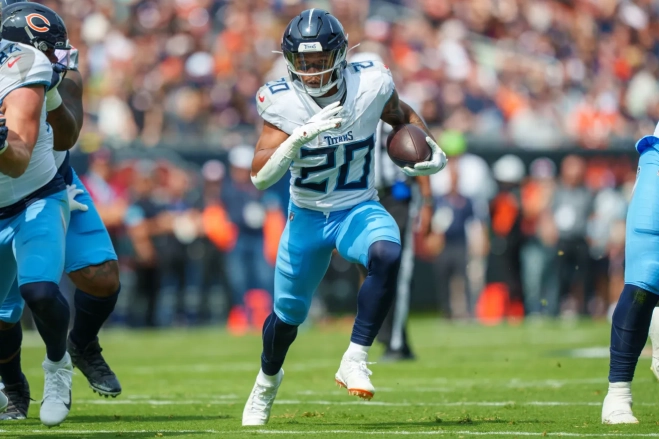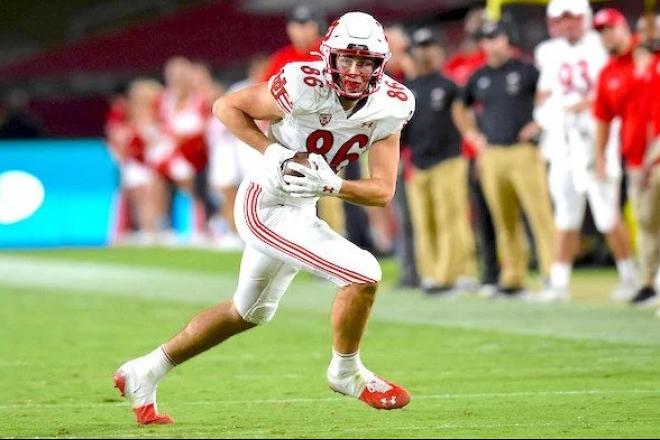A great tight end combines the roles of both an effective offensive lineman and a capable receiver. Modern TE’s have to be large enough to be effective blockers like past decades gone, but unlike previous generation stars who blocked and occasionally made plays, the modern TE is expected to be a potent weapon in a team's offensive scheme on an every down/every week basis.
To be a lethal weapon in the offensive game plan the modern tight end must have a rare mix of reliable hands, great route running, great blocking, chemistry with the QB and synergy with the rest of the pass catchers. It is said that the modern tight end is the swiss army knife of the offense.
Fifteen tight ends were taken in the 2023 NFL draft. These players have different approaches to playing the position. In this article I discuss some of these different approaches taken over the course of the 2022 NCAA season.
The following chart shows this year's TE rookie's college yards per reception vs receptions per game:

Due to limited availability of data, not all draft picks are going to be covered.
Ball-Magnet//Safety-Net//Traditional Pass Catcher
In 1961 Chicago Bears tight end Mike Ditka wowed the crowd and coaches alike with his excellent receiving skills. As a rookie, Ditka got open consistently, showed reliable catching ability and was a tough runner in the open field running through contact. At the time Ditka was a trailblazer and was the first tight end to post over 1,000 yards in a season.
This style of TE only grew in popularity as the passing game became more popular. While the modern times version isn’t as effective a blocker as Ditka once was, the receiver traits at that size are still valued by offenses of today. Examples of tight ends in today’s game of this mold include: TJ Hockenson, Zach Ertz and Darren Waller.
The traditional pass catcher/safety net tight end rookies are:
- Sam LaPorta: Detroit Lions, 2nd Round Pick 64 - Iowa
- Payne Durham: Tampa Bay Bucs, 5th Round Pick 171 - Purdue
The traditional pass catcher/safety net tight end has the following attributes:
- Great hands
- Excellent hand-eye coordination
- Good strength
- Can keep the chains moving with short to intermediate catches
- High volume of catches but low value in yardage covered
- Nose for the football
- Get their hands on the ball in volume
- Elite pass catcher tight ends rarely drop a pass
- Great contested catch ability
The weaknesses of this type of tight end are:
- Typically will not outrun the defense
- Not the best blockers unless very large
In summary, these tight ends make tough catches and embrace the contact play to secure first downs. They are used to getting hit as soon as they catch a ball.
Explosive Downfield Threats
Tight ends of this style make use of their size and speed to become dangerous open-field runners. This type of tight end add an explosive down the field dimension to any offense. These players can be used as reliable playmakers. Rob Gronkowski, Jared Cook and Vernon Davis are popular modern examples of a downfield threat TEs.
This style of TE is growing popular in the modern game as teams look to stock pile as many playmakers for the QB as possible. Examples of this type of tight end in today’s game include Kyle Pitts, Dallas Goedert and Noah Fant.
The downfield threat tight end rookies are:
- Luke Schoonmaker: Dallas Cowboys, 2nd Round Pick 58 - Michigan
- Cameron Latu: San Francisco 49ers, 3rd Round Pick 101 - Alabama
- Will Mallory: Indianapolis Colts, 5th Round Pick 162 - Miami (FL)
- Brayden Willis: San Francisco 49ers, 7th Round Pick 247 - Oklahoma
The explosive downfield threat tight end has the following attributes:
- Explosive speed
- Detonates off the line of scrimmage.
- Easy separation when defender is beat and only space ahead
- Hand-eye coordination to make over-the-shoulder catches
- They don't receive the ball as often as possession tight ends but every catch they make is a scoring threat no matter the distance.
- Low volume of catches but high value in yardage covered
- Elite speed tight ends carry a fear factor defenses must respect, causing the defense to give them more attention and opening the field up for fellow receivers
The typical weaknesses of this type of tight end are:
- Work well as 2nd options rather than outright number #1’s due to their low volume of catches per game despite the high quality of yardage of those catches.
- Due to size routes are not as clean and cut to get open as smaller tight ends.
The Modern Tight End - A Weapon
The modern tight end is the total team player on offense; a capable blocker, outstanding route runner, great receiver with speed, consistent catch ability and a nose for the end zone.
These tight ends hurt defenses all over the field, securing first downs routinely with great route running, while providing the explosive play ability to take it long at any distance.
This style of TE is the most valued of any style. These tight ends fuse two previous offensive roles, providing a high volume of catches and first downs as possession tight ends while also providing the downfield scoring threat. Examples of this type of tight end in today’s game include:
- George Kittle
- Travis Kelce
- Mark Andrews
The modern tight end rookies are:
- Dalton Kincaid: Buffalo Bills, 1st Round Pick 25 - Utah
- Michael Mayer: Las Vegas Raiders, 2nd Round Pick 35 - Notre Dame
The Current State Of Tight Ends
Tight ends are a valued position. They can have the value of a great wide receiver at a discount price with added blocking included.
Of the rookies, only Dalton Kincaid and Michael Mayer seem to have the potential to do the difficult double act of high volume catches and high yardage.
Of the veterans George Kittle, Travis Kelce and Mark Andrews are a very special and valuable TEs.






